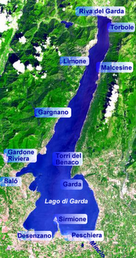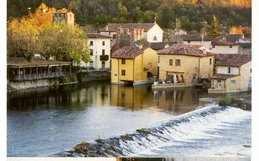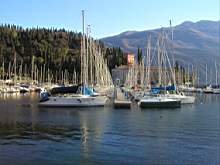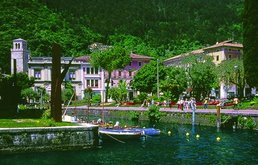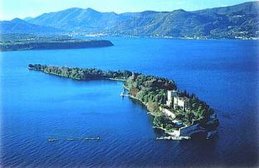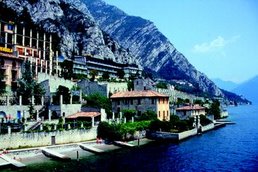
CENNI STORICI
Già capoluogo di distretto e di mandamento, sulla sponda veronese del Benaco, fra Lazise e Garda, Bardolino è oggi comune ad economia prevalentemente turistica, anche se le attività agricole vi continuano ad allignare rigogliose, producendo soprattutto quei vini che hanno reso giustamente famoso il toponimo in tutto il mondo. La popolazione è oggi concentrata nel Capoluogo. Poche persone abitano ormai i casolari sparsi, caratteristici di un’architettura rurale con esempi di singolare bellezza.
La zona, abitata fin dalla preistoria, ha restituito testimonianze notevoli della presenza d’abitanti palafitticoli. Alcuni fanno risalire le origini di Bardolino al mito di Troia; altri ne derivano l'origine da Pardali figlia di Virgiliano Aulete. La colonizzazione romana vi è testimoniata: monete, cippi, lapidi, genietti funerari furono in varie occasioni qui rinvenuti.
Anche Bardolino fu soggetta alle invasioni dei Longobardi e al dominio dei Franchi, e sembra che in conseguenza dell'invasione degli Ungari, le sponde del lago siano state fortificate con la costruzione di rocche e castelli, a scopo di difesa.Nel Medioevo, Bardolino fu uno dei principali comuni lacustri, divenendo poi fortificata cittadella scaligera, resti della quale sono ancora visibili. Le mura medievali resistettero fino all’Ottocento e furono demolite in parte quando si costruì l'attuale chiesa parrocchiale (1830-1844) e poi all'epoca della costruzione della ferrovia Verona-Garda.
A Bardolino ha avuto i natali Cesare Betteloni, dolcissimo poeta ed entusiasta cantore del suo Garda, davanti le cui onde azzurre volle, in un giorno di sconforto, trovare morte prematura.
Già capoluogo di distretto e di mandamento, sulla sponda veronese del Benaco, fra Lazise e Garda, Bardolino è oggi comune ad economia prevalentemente turistica, anche se le attività agricole vi continuano ad allignare rigogliose, producendo soprattutto quei vini che hanno reso giustamente famoso il toponimo in tutto il mondo. La popolazione è oggi concentrata nel Capoluogo. Poche persone abitano ormai i casolari sparsi, caratteristici di un’architettura rurale con esempi di singolare bellezza.
La zona, abitata fin dalla preistoria, ha restituito testimonianze notevoli della presenza d’abitanti palafitticoli. Alcuni fanno risalire le origini di Bardolino al mito di Troia; altri ne derivano l'origine da Pardali figlia di Virgiliano Aulete. La colonizzazione romana vi è testimoniata: monete, cippi, lapidi, genietti funerari furono in varie occasioni qui rinvenuti.
Anche Bardolino fu soggetta alle invasioni dei Longobardi e al dominio dei Franchi, e sembra che in conseguenza dell'invasione degli Ungari, le sponde del lago siano state fortificate con la costruzione di rocche e castelli, a scopo di difesa.Nel Medioevo, Bardolino fu uno dei principali comuni lacustri, divenendo poi fortificata cittadella scaligera, resti della quale sono ancora visibili. Le mura medievali resistettero fino all’Ottocento e furono demolite in parte quando si costruì l'attuale chiesa parrocchiale (1830-1844) e poi all'epoca della costruzione della ferrovia Verona-Garda.
A Bardolino ha avuto i natali Cesare Betteloni, dolcissimo poeta ed entusiasta cantore del suo Garda, davanti le cui onde azzurre volle, in un giorno di sconforto, trovare morte prematura.
DA VEDERE
Castello.
Del primitivo castello di Bardolino poco si conosce, anche se si ritiene che, sul finire del IX secolo, re Berengario, incapace di respingere gli Ungari, abbia consentito di costruire rocche e fortilizi a difesa dei paesi lacustri. Con gli Scaligeri, il castello fu rifatto ed ampliato organicamente, con mura robuste rinforzate da torri, spalti e merlature: circondato da un fossato, comunicava, attraverso porta San Giovanni (o superiore) a nord con Garda e con porta Verona (o inferiore) a sud-est. Una delle più antiche carte topografiche del lago rappresentano Bardolino in dimensione quasi quadrata, che comprende il porto fra due speroni che si protendono verso il lago, una torre nell'angolo sud-est sopra porta Verona del castello, la piazza caseggiata e nel fondo il campaniletto acuspidato di San Nicolò. Come si è detto, soltanto pochi resti del castello e delle fortificazioni di Bardolino sono oggi visibili: le due porte d'accesso e la mozza torre rettangolare sul lungolago.
Le chiese.
• Quella di S. Zeno è una piccola chiesa che fu dedicata al Santo patrono e che risale all'ottavo o nono secolo. La cappella di san Zeno ha la forma di croce e la volta a botte. Nel tamburo è racchiusa una volta a crociera che probabilmente è originale. I capitelli delle colonne della chiesa sono molto simili a quelli d’altre chiese lombarde; si suppone quindi che siano state costruite da maestranze provenienti dalla vicina Lombardia.
• Ben conservato - anche per una serie di restauri - è il complesso romanico della chiesa di S. Severo (sec. XII), con importanti cicli d’affreschi e resti di una cripta altomedievale. La chiesa, non più officiata, rimase a lungo in uno stato abbandono. Nel 1869 divenne proprietà del Comune e fu trasformata in teatro. Lavori di restauro furono iniziati nel 1927 con la demolizione dell'abside maggiore, quadrata. Si continuò poi lo scavo della cripta e, nel 1932, si ricostruì sulle fondamenta antiche l'abside maggiore.
• La chiesa parrocchiale è dedicata ai SS. Nicolò e Severo e fu rifatta (sopra l'antica eretta pare nel sec. XV) nel 1842, in stile corinzio con ampio pronao su disegno di B. Giuliari. L’interno ha pregevoli pitture di G. Bevilacqua.
• Poco lontano dal paese, si trova la bella chiesa di S. Maria della Disciplina, del 1396. Qui è l'arca sepolcrale di Fermo Fermi, appartenente a famiglia bardolinese, illustre per casato ed opere.
• Altre chiese sono sparse per la campagna. A Corteline, in desolato abbandono, giace la chiesetta romanica di S. Vito (sec. XIII), col piccolo campanile a bifora: essa dipendeva dal monastero di San Colombano e rimase abbandonata nel secolo XVII.
• Al confine fra i Comuni di Bardolino e Garda è una chiesa del sec. XII, dedicata a S. Pietro.
• Sulle colline si trova l'eremo con la chiesa di S. Giorgio, che sottentrò ad un’omonima più antica, dal 1530 soggetta al priorato di S. Colombano. Quando questa fu abbattuta, i Camaldolesi ne edificarono una nuova, nel 1669.
• In località Paerno, si trova un oratorio dedicato a S. Francesco, del sec. XVII, ed il sacello dedicato a S. Zeno, che risale all'VIII-IX secolo e che è uno dei più interessanti monumenti dell'architettura carolingia veronese e dell'Italia settentrionale.
Le ville.
• Villa Rizzardi-Guerrieri, ottocentesca, di non alto valore architettonico, fu costruita sull'area di altra più antica. Con un bel portale classico d’accesso al giardino dal paese, ha di notevole il parco, prospiciente il lago, con resti d’antico castello o fortilizio.
• Villa Bassani Raimondi, non presenta particolari pregi architettonici (risale, infatti, al primo Ottocento). Era però apprezzata, fino a pochi decenni fa, per un denso parco, devastato dalla guerra e dall’incuria.
• Anche villa Giuliari-Gianfilippi, ottocentesca, non ha particolare interesse architettonico; però possiede un bel parco, disteso lungo il lago, nella parte meridionale della baia di Bardolino, al quale fa riscontro il parco dei Bottagisio.
• Villa Bottagisio, infine, sul lungolago, è una costruzione ottocentesca piuttosto ibrida, anch'essa con un bel parco che si stende lungo il lago ed occupa tutta la parte settentrionale della baia di Bardolino.
• Casa Ottolenghi è recente, essendo stata iniziata nel 1974, su progetto di Carlo Scarpa. La villa poggia e si impernia su nove pilastri d’ordine “gigante”, formati da dischi di diverso materiale e colore. Il tetto, a terrazze, armonizza con l’ambiente e sembra continuare il declivio che unisce la villa al colle retrostante
• Quella di S. Zeno è una piccola chiesa che fu dedicata al Santo patrono e che risale all'ottavo o nono secolo. La cappella di san Zeno ha la forma di croce e la volta a botte. Nel tamburo è racchiusa una volta a crociera che probabilmente è originale. I capitelli delle colonne della chiesa sono molto simili a quelli d’altre chiese lombarde; si suppone quindi che siano state costruite da maestranze provenienti dalla vicina Lombardia.
• Ben conservato - anche per una serie di restauri - è il complesso romanico della chiesa di S. Severo (sec. XII), con importanti cicli d’affreschi e resti di una cripta altomedievale. La chiesa, non più officiata, rimase a lungo in uno stato abbandono. Nel 1869 divenne proprietà del Comune e fu trasformata in teatro. Lavori di restauro furono iniziati nel 1927 con la demolizione dell'abside maggiore, quadrata. Si continuò poi lo scavo della cripta e, nel 1932, si ricostruì sulle fondamenta antiche l'abside maggiore.
• La chiesa parrocchiale è dedicata ai SS. Nicolò e Severo e fu rifatta (sopra l'antica eretta pare nel sec. XV) nel 1842, in stile corinzio con ampio pronao su disegno di B. Giuliari. L’interno ha pregevoli pitture di G. Bevilacqua.
• Poco lontano dal paese, si trova la bella chiesa di S. Maria della Disciplina, del 1396. Qui è l'arca sepolcrale di Fermo Fermi, appartenente a famiglia bardolinese, illustre per casato ed opere.
• Altre chiese sono sparse per la campagna. A Corteline, in desolato abbandono, giace la chiesetta romanica di S. Vito (sec. XIII), col piccolo campanile a bifora: essa dipendeva dal monastero di San Colombano e rimase abbandonata nel secolo XVII.
• Al confine fra i Comuni di Bardolino e Garda è una chiesa del sec. XII, dedicata a S. Pietro.
• Sulle colline si trova l'eremo con la chiesa di S. Giorgio, che sottentrò ad un’omonima più antica, dal 1530 soggetta al priorato di S. Colombano. Quando questa fu abbattuta, i Camaldolesi ne edificarono una nuova, nel 1669.
• In località Paerno, si trova un oratorio dedicato a S. Francesco, del sec. XVII, ed il sacello dedicato a S. Zeno, che risale all'VIII-IX secolo e che è uno dei più interessanti monumenti dell'architettura carolingia veronese e dell'Italia settentrionale.
Le ville.
• Villa Rizzardi-Guerrieri, ottocentesca, di non alto valore architettonico, fu costruita sull'area di altra più antica. Con un bel portale classico d’accesso al giardino dal paese, ha di notevole il parco, prospiciente il lago, con resti d’antico castello o fortilizio.
• Villa Bassani Raimondi, non presenta particolari pregi architettonici (risale, infatti, al primo Ottocento). Era però apprezzata, fino a pochi decenni fa, per un denso parco, devastato dalla guerra e dall’incuria.
• Anche villa Giuliari-Gianfilippi, ottocentesca, non ha particolare interesse architettonico; però possiede un bel parco, disteso lungo il lago, nella parte meridionale della baia di Bardolino, al quale fa riscontro il parco dei Bottagisio.
• Villa Bottagisio, infine, sul lungolago, è una costruzione ottocentesca piuttosto ibrida, anch'essa con un bel parco che si stende lungo il lago ed occupa tutta la parte settentrionale della baia di Bardolino.
• Casa Ottolenghi è recente, essendo stata iniziata nel 1974, su progetto di Carlo Scarpa. La villa poggia e si impernia su nove pilastri d’ordine “gigante”, formati da dischi di diverso materiale e colore. Il tetto, a terrazze, armonizza con l’ambiente e sembra continuare il declivio che unisce la villa al colle retrostante
HISTORICAL SIGNALS
Already capoluogo of district and district, on the veronese side of the Benaco, between Lazise and Garda, Bardolino it is today common to mostly tourist economy, even if the agricultural activities continue to you to allignare rigogliose, producing above all those wines that have rendered the toponimo with justice famous all over the world. The population today is concentrated in the Capoluogo. Little persons inhabit the scattered casolari, characteristic of a rural architecture with examples of singular beauty by now. The zone, inhabited since the preistoria, has given back remarkable testimonies of the presence of palafitticoli inhabitants. Some make to go back the origins of Bardolino to the myth of Troy; others of it derive the origin from Pardali daughter of Virgiliano Aulete. The roman colonization is testified to you: coins, cippi, stone to death, genietti funerari were in several occasions recovered here. Also Bardolino was subject to the invasions of the Longobardi and the dominion of the Franchi, and seems that as a result of the invasion of the Ungari, the sides of the lago has been fortified with the construction of rocche and castles, for the sake of defense. In the Middle Ages, Bardolino was one of main common the lacustrine ones, becoming then fortified scaligera citadel, rests of which they are still visible. It walls medieval they will resist until the 1800's and were demolished partially when constructed itself puts into effect it them parochial church (1830-1844) and to the age of the construction of the Verona-Garda railroad then. To Bardolino it has had the NATO them Cesar Betteloni, sweet poet and enthusiastic singer of its Garda, whose blue waves wanted, in a day of sconforto, to find dead women premature.
TO SEE
Castle.
Of the primitivo castle of Bardolino little it is known, even if one thinks that, on ending of IX the century, king Berengario, incapable to reject the Ungari, has concurred to construct rocche and fortilizi to defense of the lacustrine countries. With the Scaligeri, the castle was rifared and widened organic, with walls sturdy reinforced from towers, spalti and merlature: encircled from a ditch, it communicated, through door Saint Giovanni (or advanced) to north with Garda and Verona door (or inferior) to south-east. One of more ancient papers topographical of lago represent Bardolino in dimension nearly square, that it comprises the port between two spurs that protendono towards the lago, one tower in the angle south-east over Verona door of the castle, the caseggiata public square and in the acuspidato bottom the campaniletto of Saint Nicolò. As it has been said, only little rests of the castle and the fortifications of Bardolino are today visible: the two doors of access and the truncated rectangular tower on the lungolago.
The churches.
• That one of S. Zeno is one small church that was dedicated to the Saint patron and that laughed them to the eighth or ninth century. The nail head of saint Zeno has the cross shape and the time to botte. In the drum it is enclosed once to cruise that probably is originates them. The capitelli of the columns of the church they are much similar to those of other Lombardic churches; one supposes therefore that they have been constructed from coming from maestranze from the Lombardy neighbor. • Very conserved - also for a series of restorations - it is the Romanesque complex of the Strict church of S. (sec. XII), with important cycles of it frescoes and rests of one cripta altomedievale. The church, not more officiata, remained over a long time span in one be abandonment. In the 1869 divenne property of the Common one and it was transformed in theatre. Jobs of restoration were begin to you in 1927 with the demolition of the greater, square apse. The digging was continued then of cripta and, in 1932, the greater apse was reconstructed on the ancient foundations. • The parochial church is dedicated to the SS. Nicolò and Severo and were rifared (over the ancient one erected seem in sec. the XV) in 1842, in style corinzio with wide pronao on design of B. Giuliari. The inside has pregevoli paintings of G. Bevilacqua. • Little far away from the country, the beautiful church of S is found. Maria of the Discipline, of 1396. Here it is arches it burial of Detention Firm, pertaining to bardolinese, illustrious family for casato and works. • Other churches are scattered for the campaign. To Corteline, in desolated abandonment, Vito (sec. XIII lies chiesetta Romanesque of S.), with the small bell tower to double lancet window: it depended on the monastero of Saint Colombano and remained abandoned in century XVII. • To the border between the Common ones of Bardolino and Garda church of sec. the XII is one, dedicated to S. Peter. • On hills the George finds itself eremo with the church of S., than sottentrò to a omonima more ancient, from the 1530 subject one to the priorato one of S. Colombano. When this was inclination to leeward, the Camaldolesi of it built up one new, in 1669. • In Paerno locality, an oratory dedicated to S is found. Francisco, of sec. the XVII, and the sacello dedicated to S. Zeno, than laughed them to the VIII-IX century and that it is one of the more interesting monuments of the veronese architecture carolingia and of northern Italy.
The villas.
• Rizzardi-Guerrieri Villa, nineteenth-century, not high architectonic value, was constructed on the area of altra più antica. Con un bel portale classico d’accesso al giardino dal paese, ha di notevole il parco, prospiciente il lago, con resti d’antico castello o fortilizio. • Villa Bassani Raimondi, non presenta particolari pregi architettonici (risale, infatti, al primo Ottocento). Era però apprezzata, fino a pochi decenni fa, per un denso parco, devastato dalla guerra e dall’incuria. • Anche villa Giuliari-Gianfilippi, ottocentesca, non ha particolare interesse architettonico; però possiede un bel parco, disteso lungo il lago, nella parte meridionale della baia di Bardolino, al quale fa riscontro il parco dei Bottagisio. • Villa Bottagisio, infine, sul lungolago, è una costruzione ottocentesca piuttosto ibrida, anch'essa con un bel parco che si stende lungo il lago ed occupa tutta la parte settentrionale della baia di Bardolino. • Casa Ottolenghi è recente, essendo stata iniziata nel 1974, su progetto di Carlo Scarpa. La villa poggia e si impernia su nove pilastri d’ordine “gigante”, formati da dischi di diverso materiale e colore. Il tetto, a terrazze, armonizza con l’ambiente e sembra continuare il declivio che unisce la villa al colle retrostante.








